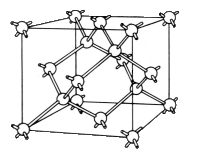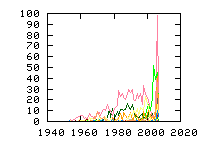« Previous
1
Next »
(11 hits, 1/1)
Showing
10, 25, 50, 100, 500, 1000, all papers per page.
Sort by:
last publication date,
older publication date,
last update date.
- 1. Appl. Phys. Lett. 91, 133507 (2007) , “Identification of atomic-scale defect structure involved in the negative bias temperature instability in plasma-nitrided devices”, J. P. Campbell, P. M. Lenahan, A. T. Krishnan, and S. KrishnanWe utilize a very sensitive electron spin resonance technique called spin-dependent tunneling to identify defect centers involved in the negative bias temperature instability in plasma-nitrided p-channel metal-oxide-silicon field-effect transistors. The defect's 29Si hyperfine... (Read more)
- 2. Phys. Rev. B 75, 193201 (2007) , “Compensating point defects in 4He+-irradiated InN”, F. Tuomisto, A. Pelli, K. M. Yu, W. Walukiewicz, and W. J. SchaffWe use positron annihilation spectroscopy to study 2 MeV 4He+-irradiated InN grown by molecular-beam epitaxy and GaN grown by metal-organic chemical-vapor deposition. In GaN, the Ga vacancies act as important compensating centers in the irradiated material, introduced at a... (Read more)
- 3. Phys. Rev. Lett. 98, 026101 (2007) , “Bonding at the SiC-SiO2 Interface and the Effects of Nitrogen and Hydrogen”, Sanwu Wang, S. Dhar, Shu-rui Wang, A. C. Ahyi, A. Franceschetti, J. R. Williams, L. C. Feldman,, and Sokrates T. PantelidesUnlike the Si-SiO2 interface, the SiC-SiO2 interface has large defect densities. Though nitridation has been shown to reduce the defect density, the effect of H remains an open issue. Here we combine experimental data and the results of first-principles calculations to... (Read more)
- 4. Appl. Phys. Lett. 89, 152910 (2006) , “Characterization of atomic-layer-deposited Al2O3/GaAs interface improved by NH3 plasma pretreatment”, Hong-Liang Lu, Liang Sun, Shi-Jin Ding, Min Xu, David Wei Zhang, and Li-Kang WangAl2O3 thin films were deposited by atomic layer deposition on HF-cleaned and NH3 plasma-treated GaAs surfaces, respectively. The precursors used for Al2O3 films are trimethylaluminum and water. Effects of NH3 plasma pretreatment on... (Read more)
- 5. J. Appl. Phys. 99, 103507 (2006) , “Nonconservative Ostwald ripening of a dislocation loop layer under inert nitrogen-rich SiO2/Si interfaces”, D. Skarlatos, P. Tsouroutas, V. Em. Vamvakas, and C. TsamisIn this work we perform a systematic study of the dissolution of a dislocation loop layer under the influence of inert SiO2/Si and nitrogen-rich SiO2/Si interfaces. The composition of the dislocation loop layer was just after its formation 10%–20% Frank dislocation loops... (Read more)
- 6. Microelectron. Reliability 45, 57 (2005) , “Characterization of interface defects related to negative-bias temperature instability SiON/Si<100> systems ”,Interface defects related to negative-bias temperature instability (NBTI) in an ultrathin plasma-nitrided SiON/ Si<100> system were characterized by using conductance–frequency measurements, electron-spin resonance measure- ments, and synchrotron radiation X-ray photoelectron spectroscopy. It was confirmed that NBTI is reduced by using D2-annealing instead of the usual H2-annealing. Interfacial Si dangling bonds (Pb1 and Pb0 centers) were detected in a sample subjected to negative-bias temperature stress (NBTS). Although we suggest that NBTS also generates non-Pb defects, it does not seem to generate nitrogen dangling bonds. These results show that NBTI of the plasma-nitrided SiON/Si system is predominantly due to Pb depassivation. Plasma nitridation was also found to increase the Pb1/Pb0 density ratio, modify the Pb1 defect structure, and increase the latent interface trap density by generating Si suboxides at the interface. These changes are likely to be the causes of NBTI in ultrathin plasma-nitrided SiON/Si systems. (Read more)
- 7. J. Appl. Phys. 95, 4096 (2004) , “Nitridation effects on Pb center structures at SiO2/Si(100) interfaces ”,Interfacial defect structures of NO-nitride oxide on Si(100) were characterized by electron spin resonance spectroscopy. We confirmed that the effective g values of the Pb1 center are affected by interfacial nitridation even at a small nitrogen concentration of 5 at. %, while those of the Pb0 center proved to be unchanged. We observed that the shifted Pb1 line appeared gradually with interfacial nitrogen concentration, which suggests that the nitrogen-induced modified structure substitutes for the original Pb1 structure. Angular variations of the shifted Pb1 lines were also significantly different from those of pure oxide. Based on our analysis, we attributed the g value shift of the Pb1 center to dangling bond tilting, caused by the displacement of nearest-neighbor Si atoms. (Read more)
- 8. Appl. Phys. Lett. 82, 3677-3679 (2003) , “Interface defects responsible for negative-bias temperature instability in plasma-nitrided SiON/Si(100) systems”, Shinji Fujieda, Yoshinao Miura, and Motofumi SaitohInterface defects generated by negative-bias temperature stress (NBTS) in an ultrathin plasma- nitrided SiON/Si(100) system were characterized by using D2 annealing, conductance-frequency measurements, and electron-spin resonance measurements. D2 annealing was shown to lower... (Read more)
- 9. J. Appl. Phys. 94, 1 (2003) , “Negative bias temperature instability: Road to cross in deep submicron silicon semiconductor manufacturing”,We present an overview of negative bias temperature instability (NBTI) commonly observed in p-channel metal–oxide–semiconductor field-effect transistors when stressed with negative gate voltages at elevated temperatures. We discuss the results of such stress on device and circuit... (Read more)
- 10. Appl. Phys. Lett. 81, 1818 (2002) , “Interface structures generated by negative-bias temperature instability in Si/SiO2 and Si/SiOxNy interfaces”, J. Ushio, T. Maruizumi, K. Kushida-AbdelghafarWe used a density functional method to investigate the mechanism of negative-bias temperature instability (NBTI) and resultant structural changes of Si/SiO2 and Si/SiOxNy interfaces. The reaction energies for the water- and hydrogen-originated... (Read more)
- 11. J. Vac. Sci. Technol. B 16, 2134-2153 (1998) , “What can electron paramagnetic resonance tell us about the Si/SiO2 system?”, P. M. Lenahan, J. F. Conley, Jr.Electron paramagnetic resonance (EPR) measurements of Si/SiO2 systems began over 30 years ago. Most EPR studies of Si/SiO2 systems have dealt with two families of defects: Pb centers and E centers. Several variants from each group have... (Read more)BPSG PSG Si SiO2| EDMR EPR electric-field-effect electrical-meas. etching gamma-irradiation| 10B 11B 1H 29Si 2D 31P BOHC Boron Deuterium E' E'-delta H(I) Hydrogen Nb Nitrogen Oxygen P1 P2 P4 POHC Pb Pb0 Pb1 Phosphorus Silicon amorphous complex(=3) dangling-bond device dielectric interface pair(=2) | last update: Takahide Umeda
« Previous
1
Next »
(11 hits, 1/1)
Showing
10, 25, 50, 100, 500, 1000, all papers per page.
Sort by:
last publication date,
older publication date,
last update date.
All papers (3399)
Updated at 2010-07-20 16:50:39
Updated at 2010-07-20 16:50:39
(view as: tree
,
cloud
)
| 1329 | untagged |
Materials
(111 tags)
Others(101 tags)
Technique
(46 tags)
Details
(591 tags)
Bond(35 tags)
Defect(interstitial)(18 tags)
Defect(vacancy)(15 tags)
Defect-type(19 tags)
Element(65 tags)
Energy(8 tags)
Isotope(56 tags)
Label(303 tags)
Sample(17 tags)
Spin(8 tags)
Symmetry(15 tags)

